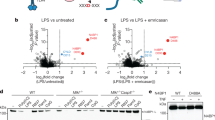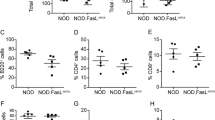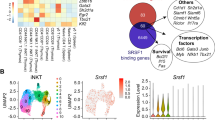Abstract
Fas ligand (FasL), an apoptosis-inducing member of the TNF cytokine family, and its receptor Fas are critical for the shutdown of chronic immune responses1,2,3 and prevention of autoimmunity4,5. Accordingly, mutations in their genes cause severe lymphadenopathy and autoimmune disease in mice6,7 and humans8,9. FasL function is regulated by deposition in the plasma membrane and metalloprotease-mediated shedding10,11. Here we generated gene-targeted mice that selectively lack either secreted FasL (sFasL) or membrane-bound FasL (mFasL) to resolve which of these forms is required for cell killing and to explore their hypothesized non-apoptotic activities. Mice lacking sFasL (FasLΔs/Δs ) appeared normal and their T cells readily killed target cells, whereas T cells lacking mFasL (FasLΔm/Δm ) could not kill cells through Fas activation. FasLΔm/Δm mice developed lymphadenopathy and hyper-gammaglobulinaemia, similar to FasLgld/gld mice, which express a mutant form of FasL that cannot bind Fas, but surprisingly, FasLΔm/Δm mice (on a C57BL/6 background) succumbed to systemic lupus erythematosus (SLE)-like autoimmune kidney destruction and histiocytic sarcoma, diseases that occur only rarely and much later in FasLgld/gld mice. These results demonstrate that mFasL is essential for cytotoxic activity and constitutes the guardian against lymphadenopathy, autoimmunity and cancer, whereas excess sFasL appears to promote autoimmunity and tumorigenesis through non-apoptotic activities.
This is a preview of subscription content, access via your institution
Access options
Subscribe to this journal
Receive 51 print issues and online access
$199.00 per year
only $3.90 per issue
Buy this article
- Purchase on Springer Link
- Instant access to full article PDF
Prices may be subject to local taxes which are calculated during checkout




Similar content being viewed by others
References
Hughes, P. D. et al. Apoptosis regulators Fas and Bim cooperate in shutdown of chronic immune responses and prevention of autoimmunity. Immunity 28, 197–205 (2008)
Hutcheson, J. et al. Combined deficiency of proapoptotic regulators Bim and Fas results in the early onset of systemic autoimmunity. Immunity 28, 206–217 (2008)
Weant, A. E. et al. Apoptosis regulators Bim and Fas function concurrently to control autoimmunity and CD8+ T cell contraction. Immunity 28, 218–230 (2008)
Krammer, P. H. CD95's deadly mission in the immune system. Nature 407, 789–795 (2000)
Peter, M. E. et al. The CD95 receptor: apoptosis revisited. Cell 129, 447–450 (2007)
Watanabe-Fukunaga, R. et al. The cDNA structure, expression, and chromosomal assignment of the mouse Fas antigen. J. Immunol. 148, 1274–1279 (1992)
Takahashi, T. et al. Generalized lymphoproliferative disease in mice, caused by a point mutation in the Fas ligand. Cell 76, 969–976 (1994)
Rieux-Laucat, F. et al. Mutations in Fas associated with human lymphoproliferative syndrome and autoimmunity. Science 268, 1347–1349 (1995)
Fisher, G. H. et al. Dominant interfering Fas gene mutations impair apoptosis in a human autoimmune lymphoproliferative syndrome. Cell 81, 935–946 (1995)
Trambas, C. M. & Griffiths, G. M. Delivering the kiss of death. Nature Immunol. 4, 399–403 (2003)
Schulte, M. et al. ADAM10 regulates FasL cell surface expression and modulates FasL-induced cytotoxicity and activation-induced cell death. Cell Death Differ. 14, 1040–1049 (2007)
Schneider, P. et al. Conversion of membrane-bound Fas(CD95) ligand to its soluble form is associated with downregulation of its proapoptotic activity and loss of liver toxicity. J. Exp. Med. 187, 1205–1213 (1998)
Tanaka, M., Itai, T., Adachi, M. & Nagata, S. Downregulation of Fas ligand by shedding. Nature Med. 4, 31–36 (1998)
Hohlbaum, A. M., Moe, S. & Marshak-Rothstein, A. Opposing effects of transmembrane and soluble Fas ligand expression on inflammation and tumor cell survival. J. Exp. Med. 191, 1209–1219 (2000)
Siegel, R. M. et al. Fas preassociation required for apoptosis signaling and dominant inhibition by pathogenic mutations. Science 288, 2354–2357 (2000)
Chen, J.-J., Sun, Y. & Nabel, G. J. Regulation of the proinflammatory effects of Fas ligand (CD95L). Science 282, 1714–1717 (1998)
Wilson, N. S., Dixit, V. & Ashkenazi, A. Death receptor signal transducers: nodes of coordination in immune signaling networks. Nature Immunol. 10, 348–355 (2009)
Ahn, J. H. et al. Non-apoptotic signaling pathways activated by soluble Fas ligand in serum-starved human fibroblasts. Mitogen-activated protein kinases and NF-κB-dependent gene expression. J. Biol. Chem. 276, 47100–47106 (2001)
Xiao, S., Jodo, S., Sung, S. S., Marshak-Rothstein, A. & Ju, S. T. A novel signaling mechanism for soluble CD95 ligand. Synergy with anti-CD95 monoclonal antibodies for apoptosis and NF-κB nuclear translocation. J. Biol. Chem. 277, 50907–50913 (2002)
Oliveira, J. B. et al. NRAS mutation causes a human autoimmune lymphoproliferative syndrome. Proc. Natl Acad. Sci. USA 104, 8953–8958 (2007)
Kono, D. H. & Theofilopoulos, A. N. Genetic susceptibility to spontaneous lupus in mice. Curr. Dir. Autoimmun. 1, 72–98 (1999)
Watanabe, D., Suda, T., Hashimoto, H. & Nagata, S. Constitutive activation of the Fas ligand gene in mouse lymphoproliferative disorders. EMBO J. 14, 12–18 (1995)
Ogasawara, J. et al. Lethal effect of the anti-Fas antibody in mice. Nature 364, 806–809 (1993)
Huang, D. C. et al. Activation of Fas by FasL induces apoptosis by a mechanism that cannot be blocked by Bcl-2 or Bcl-xL . Proc. Natl Acad. Sci. USA 96, 14871–14876 (1999)
Strand, S. et al. Lymphocyte apoptosis induced by CD95 (APO-1/Fas) ligand-expressing tumor cells—a mechanism of immune evasion? Nature Med. 2, 1361–1366 (1996)
Fredrickson, T. N. & Harris, A. W. Atlas of Mouse Hematopathology (Harwood Academic, 2000)
Frith, C. H. & Wiley, L. D. Morphologic classification and correlation of incidence of hyperplastic and neoplastic hematopoietic lesions in mice with age. J. Gerontol. 36, 534–545 (1981)
Suzuki, I. & Fink, P. J. Maximal proliferation of cytotoxic T lymphocytes requires reverse signaling through Fas ligand. J. Exp. Med. 187, 123–128 (1998)
Sun, M. & Fink, P. J. A new class of reverse signaling costimulators belongs to the TNF family. J. Immunol. 179, 4307–4312 (2007)
Karray, S. et al. Complete loss of Fas ligand gene causes massive lymphoproliferation and early death, indicating a residual activity of gld allele. J. Immunol. 172, 2118–2125 (2004)
Schwenk, F., Baron, U. & Rajewsky, K. A cre-transgenic mouse strain for the ubiquitous deletion of loxP-flanked gene segments including deletion in germ cells. Nucleic Acids Res. 23, 5080–5081 (1995)
Phillips, J. M., O'Reilly, L., Bland, C., Foulis, A. K. & Cooke, A. Patients with chronic pancreatitis have islet progenitor cells in their ducts, but reversal of overt diabetes in NOD mice by anti-CD3 shows no evidence for islet regeneration. Diabetes 56, 634–640 (2007)
Pileri, S. A. et al. Tumours of histiocytes and accessory dendritic cells: an immunohistochemical approach to classification from the International Lymphoma Study Group based on 61 cases. Histopathology 41, 1–29 (2002)
Blott, E. J., Bossi, G., Clark, R., Zvelebil, M. & Griffiths, G. M. Fas ligand is targeted to secretory lysosomes via a proline-rich domain in its cytoplasmic tail. J. Cell Sci. 114, 2405–2416 (2001)
Naik, S., Vremec, D., Wu, L., O'Keeffe, M. & Shortman, K. CD8α+ mouse spleen dendritic cells do not originate from the CD8 α-dendritic cell subset. Blood 102, 601–604 (2003)
Hibbs, M. L. et al. Multiple defects in the immune system of Lyn-deficient mice, culminating in autoimmune disease. Cell 83, 301–311 (1995)
Lyons, A. B. & Parish, C. R. Determination of lymphocyte division by flow cytometry. J. Immunol. Methods 171, 131–137 (1994)
Kilbourne, E. D. Future influenza vaccines and the use of genetic recombinants. Bull. WHO 41, 643–645 (1969)
Flynn, K. J. et al. Virus-specific CD8+ T cells in primary and secondary influenza pneumonia. Immunity 8, 683–691 (1998)
Belz, G. T., Xie, W., Altman, J. D. & Doherty, P. C. A previously unrecognized H-2D(b)-restricted peptide prominent in the primary influenza A virus-specific CD8(+) T-cell response is much less apparent following secondary challenge. J. Virol. 74, 3486–3493 (2000)
Belz, G. T., Xie, W. & Doherty, P. C. Diversity of epitope and cytokine profiles for primary and secondary influenza a virus-specific CD8+ T cell responses. J. Immunol. 166, 4627–4633 (2001)
Acknowledgements
We thank Genentech, in particular A. Ashkenazi and S. Masters, for Fas-Fc fusion proteins. We also thank our colleagues at the Walter and Eliza Hall Institute of Medical Research (Melbourne), G. Siciliano, N. Iannarella, J. Coughlin for animal care; J. Corbin for automated blood analysis; B. Helbert and C. Young for genotyping; S. Mihajlovic, E. Tsui, A. Hasanein, V. Babo and K. Weston for histological sections; A. Light and K. O’Donnell for help with antibody measurements; and S. Drake for help with cytokine quantification. We also thank J. Melny (Royal Melbourne Hospital) for measuring anti-DNA antibody levels; A. Banerjee, S. Gerondakis and R. Gugasyan (Burnet Medical Research Institute, Prahran) for antibodies and advice; J. Silke and L. Wong (La Trobe University, Bundoora) for TNFα; P. Morgan for assistance with protein purification; and A. Silva and J. Sharkey for help with animal procedures (Peter MacCallum Cancer Centre). This work was supported in part by the NHMRC (programme numbers 461221 and 454569, a CJ Martin fellowship to N.M.H. and an RD Wright fellowship to L.A.O’R.). We also acknowledge support from the IRIISS (grant numbers 361646 and 257502 to P.B.), the Victorian State Government (an OIS grant), the Leukemia and Lymphoma Society (SCOR grant number 7015), the NIH (grant numbers CA043540-18 and CA80188-6), the JDRF/NHMRC, the Association for International Cancer Research, the Charles and Sylvia Viertel Charitable Foundation (to P.B.) and the Leukemia Research Foundation.
Author Contributions L.A.O’R. planned and performed most experiments and wrote the manuscript. L.T., L.L., E.A.K., S.G., W.D.F., N.M.H., D.M.T., J.-G.Z., G.T.B., M.J.S., P.B. and L.R. contributed to the planning and execution of the experiments and the writing of the manuscript. A.S. conceived the study, planned experiments and wrote the manuscript.
Author information
Authors and Affiliations
Corresponding author
Supplementary information
Supplementary Figures
This file contains Supplementary Figures 1-13 with Legends. (PDF 12100 kb)
Rights and permissions
About this article
Cite this article
O’ Reilly, L., Tai, L., Lee, L. et al. Membrane-bound Fas ligand only is essential for Fas-induced apoptosis. Nature 461, 659–663 (2009). https://doi.org/10.1038/nature08402
Received:
Accepted:
Issue Date:
DOI: https://doi.org/10.1038/nature08402
This article is cited by
-
Tumor microenvironment and immune system preservation in early-stage breast cancer: routes for early recurrence after mastectomy and treatment for lobular and ductal forms of disease
BMC Immunology (2024)
-
Harnessing TRAIL-induced cell death for cancer therapy: a long walk with thrilling discoveries
Cell Death & Differentiation (2023)
-
Therapeutic approaches targeting CD95L/CD95 signaling in cancer and autoimmune diseases
Cell Death & Disease (2022)
-
Caspase-8 auto-cleavage regulates programmed cell death and collaborates with RIPK3/MLKL to prevent lymphopenia
Cell Death & Differentiation (2022)
-
MMP7 cleavage of amino-terminal CD95 death receptor switches signaling toward non-apoptotic pathways
Cell Death & Disease (2022)
Comments
By submitting a comment you agree to abide by our Terms and Community Guidelines. If you find something abusive or that does not comply with our terms or guidelines please flag it as inappropriate.



